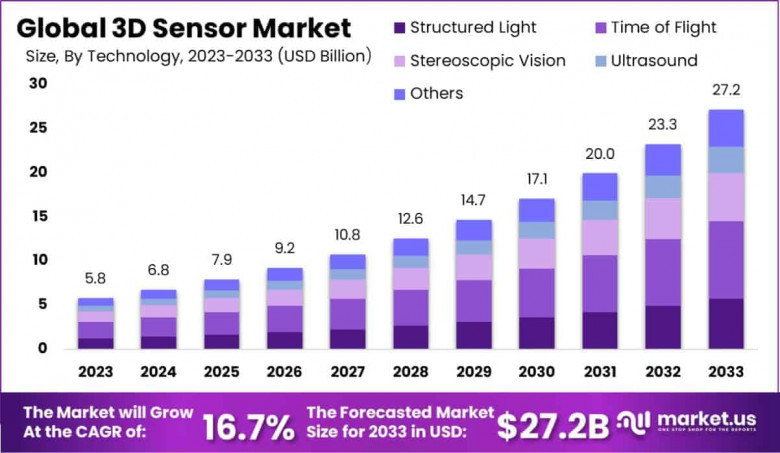views
Revolutionizing Perception: Strategic Growth and Technological Advances in the Global 3D Sensor Market
The Global 3D Sensor Market is projected to reach USD 27.2 billion by 2033, up from USD 5.8 billion in 2023, registering a robust CAGR of 16.7% during 2024–2033. This exponential growth is driven by rising demand in consumer electronics, automotive safety systems, and industrial automation.
The surge in AI and IoT adoption fuels sensor deployment across smart devices. Enhanced imaging accuracy and depth sensing enable superior interaction in AR/VR and robotics, intensifying market demand. The trend towards miniaturization, coupled with declining sensor costs, further accelerates integration across sectors, reshaping human-machine interaction and automation workflows globally.
Key Takeaways
-
Market size (2023): USD 5.8 Billion
-
Forecast (2033): USD 27.2 Billion
-
CAGR (2024–2033): 16.7%
-
North America share (2023): 38.6%
-
North America revenue (2023): USD 2.23 Billion
-
Key applications: consumer electronics, automotive, industrial automation
Dominant Market Position
North America leads the 3D sensor market, commanding a 38.6% share and generating USD 2.23 billion in 2023. This dominance is fueled by rapid technological adoption, presence of advanced R&D centers, and a high concentration of tech-forward industries. Demand is notably high across sectors such as defense, healthcare, and autonomous vehicles.
The region’s proactive investment in AI, AR/VR, and IoT ecosystems has reinforced sensor integration. Favorable government support and consumer affinity for smart devices further drive growth. With a well-established industrial base and innovation-led policies, North America is poised to maintain its lead during the forecast period.
Technology Perspective
Technological evolution in 3D sensors includes advancements in time-of-flight (ToF), stereo vision, and structured light. These technologies are enhancing real-time depth mapping, gesture recognition, facial detection, and object tracking. ToF sensors are increasingly preferred in smartphones and robotics due to their speed and accuracy.
Integration with AI chips and edge computing enables smart decision-making, optimizing power consumption and latency. The rise in MEMS technology supports miniaturization, making sensors more adaptable for wearables and portable devices. 3D sensing technologies are also revolutionizing machine vision in manufacturing, while sensor fusion enhances reliability and performance in complex environments like autonomous vehicles and drones.
Dynamic Landscape
The 3D sensor market is dynamically evolving, influenced by AI, miniaturization, and cross-industry adoption. Strategic collaborations, R&D, and patents are shaping competitive edges. Startups and tech giants alike are pushing innovation boundaries. Regulatory frameworks and sustainability considerations are emerging factors affecting product development, customization, and deployment across sectors.
Driver, Restraint, Opportunity, Challenges
Driver: Increasing demand for depth-sensing in smartphones and automotive safety systems.
Restraint: High initial cost and integration complexities.
Opportunity: Surge in AR/VR and smart home adoption.
Challenge: Standardization issues and accuracy limitations in varied lighting or weather conditions affecting sensor reliability.
Use Cases
-
Gesture recognition in smartphones and gaming
-
Collision avoidance in autonomous vehicles
-
Face recognition in security systems
-
Robotics and machine vision in manufacturing
-
Medical imaging and diagnostics
-
Augmented and virtual reality systems
Key Players Analysis
Leading companies in the 3D sensor market are aggressively investing in innovation, expanding application reach from consumer electronics to automotive and healthcare. Their focus lies in enhancing performance, reducing sensor size, and integrating AI-driven functionality. Partnerships with OEMs, strategic mergers, and robust patent portfolios are strengthening market position.
Companies are also working to address cost-efficiency and power management challenges. Global players are targeting emerging markets, especially in Asia-Pacific, for production and end-use expansion. Their R&D initiatives increasingly focus on improving depth accuracy and operational range to meet real-time data needs in robotics, autonomous navigation, and interactive device interfaces.
Recent Developments
-
Launch of ultra-compact ToF sensors for smartphones
-
Advancements in AI-integrated 3D imaging chips
-
Strategic partnerships with AR/VR companies
-
Expansion of production facilities in Asia
-
Introduction of low-power 3D sensors for wearables
Conclusion
The 3D sensor market is undergoing rapid transformation driven by technological advances and expanding application areas. With North America maintaining a dominant share and growing investments worldwide, the sector is set for sustained, high-paced expansion. Innovations in AI integration and miniaturization will play a pivotal role in shaping its future trajectory.




Comments
0 comment